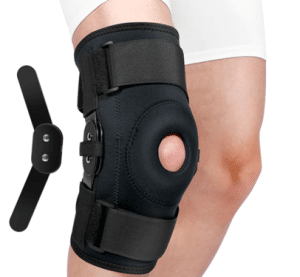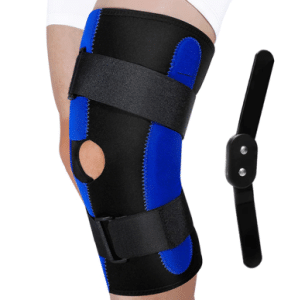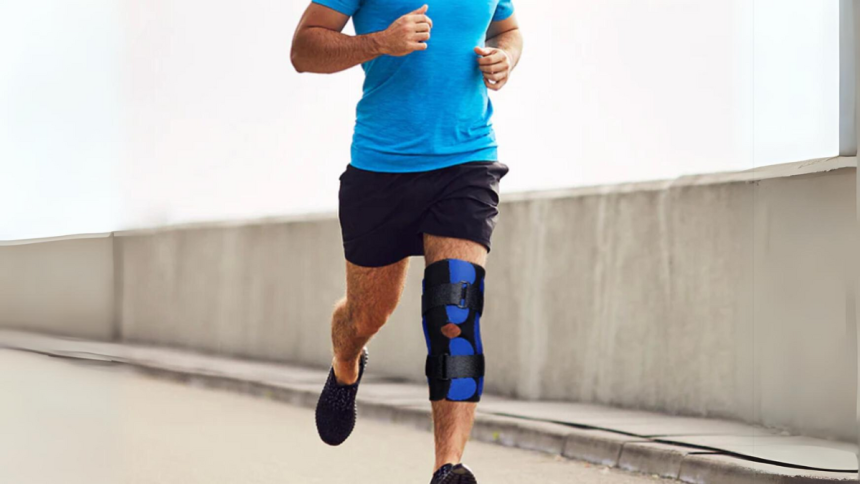If you hear doctors and coaches recommend adjustable hinged knee braces for sports protection and injury recovery but don’t know what they are, you might wonder what is so special about them and what you should know ahead. If that’s so, then you have come to the right place.
Read on to discover all the essentials about hinged knee braces!
Understanding Adjustable Hinged Knee Braces
What is an Adjustable Hinged Knee Brace?
As the name suggests, an adjustable hinged knee brace has a hinge on each side. The intention is to enhance support and limit unwanted movements of the knee area during activities. The hinged design is especially useful after an injury, requiring limited movements to facilitate healing.
Regarding their structure design, an adjustable hinged knee brace typically comes with hinges and support bars as the core feature. Adjustable buckles and straps are usually included to secure the brace and give users a snug fit.
For optimal comfort and pressure distribution, hinged knee support from quality brands also has Padding and gel inserts around the kneecap or along the sides.
When to Use an Adjustable Hinged Knee Brace?
Hinged knee supports are versatile in their applications. Here are some of the most popular use cases of adjustable knee braces with hinges:
. Injury Rehabilitation
If you have ever injured your knees by bending them sharply or tearing the ligaments, you will want to reduce excessive movements that compound the damage.
Rehabilitative braces like hinged knee braces are the often recommended for patients in the recovery stage. These braces are typically lightweight and restrain the motion around the knees. They allow your knee to move just enough that it doesn’t do any further damage, reducing healing time considerably.

. Post-Surgery Support
Having knee surgery or invasive procedures around the knees requires wearing a knee brace for post-surgery support. Hinged knee braces are usually stiffer and help immobilize and support the knee, which is traumatized by the injury and the surgery.
While limiting movement to allow for faster healing, knee braces with hinges also help reduce pain and inflammation through gentle compression from the padding and brace.
. Preventive Measure
Prophylactic braces are usually worn by athletes, sportspeople, and people with anatomical inclinations for injury prevention.
The hinged design of knee braces can prevent excessive bending or twisting and, therefore, reduce the risk of knee injuries during sports or physical activities that involve rotation or impact.
How to Put on an Adjustable Hinged Knee Brace Properly?
Your knee brace will only do its job if it is worn correctly. A poorly fitted knee brace may end up aggravating your injury. Here is a step-by-step guide on how to put on a hinged knee brace properly:
1. Prepare the Brace
Prepare the brace by opening it up and correctly positioning the hinges. Also, check your knee to ensure it is clean and patted dry. Knee braces are meant to be placed directly against the skin. You can add a knee compression sleeve underneath for additional cover and comfort.
2. Position Your Leg
With your brace ready, you should sit with your legs stretching straight. And go on to put the braces on the center of your knee.
3. Slide the Brace onto Your Leg
Next, slide the brace onto the leg. You might want to make small adjustments until the knee is correctly positioned. Once done, you can secure the straps by wrapping them around themselves. When tightening the straps, secure the bottom strap first and then secure the top strap around the thigh.
4. Adjust the Straps and Hinges Connected to the Straps
Follow this simple test to ensure that your adjustable hinged knee brace isn’t too loose or tight. Place two fingers under the brace. If the fingers can’t go under the brace, you have adjusted the straps too tightly.
The straps are too loose if the fingers can slide under the brace, leaving plenty of wiggle room. While doing so, ensure the hinges align correctly on either side of your knee joint.
5. Check for Comfort and Range of Motion
With your knee brace applied, you should move around slightly to see if it’s doing its job. It should not slide off but shouldn’t cause excessive pressure or chafing. You should be able to comfortably bend and extend your knee. If you notice any pain or numbness, your knee support is not properly fitted.
How to Wash and Maintain an Adjustable Hinged Knee Brace?
Knee braces must be washed and maintained to maintain their best performance and life span. Here is a step-by-step guide on how to wash a knee brace with hinges:
1. Check the Label
Most brace manufacturers provide care labels on the brace fabric and instructions for washing it. Check the label for the correct instructions. To avoid damage, pay special attention to the special components of a hinged knee brace.
2. Hand Wash and Gentle Cleaning
Remove detachable parts like hinges or metal inserts from your adjustable knee support with hinges before cleaning. Fill in a basin with lukewarm water and add a mild washing detergent. Place your knee brace for a couple of minutes before washing for stains to break down.
Hand washing the knee brace is generally the best option, as it helps preserve its unique structure and delicate material. If a stubborn stain persists, you might need to scrub its gently with a soft brush.
3. Avoid Harsh Chemicals
Avoid using harsh chemicals or cleaning liquids to wash your knee brace. Harsh chemicals might cause the brace material to lose elasticity, strength, and overall durability. Residual harsh chemicals may also irritate the skin.
4. Air Dry and Avoid Wringing
For best results, always air-dry your knee brace. Avoid wringing or twisting the brace, which may compromise its structure and elasticity.
5. Hinge Maintenance
For the hinges, remove any dust or debris with a cloth, then top off with a silicone lubricant on the hinges. Wipe off any excess and wipe once again before you put it back to use.
6. Store Properly
Keep your knee brace in a cool and dry place when not used. Unfasten all straps, buckles, and Velcro to relieve tension and prevent deformation. Avoid folding, as it may cause creases. Instead, just lay it flat or roll it gently.
FIVALI Adjustable Hinged Knee Braces Recommendation
FIVALI offers a wide range of hinged knee braces, each delivering the support and stability your knee joints need.
| Fivali Adjustable Hinged Knee Brace | |
 |
. Optimal Stability & Support: Presence of well-designed hinges and cushioning pad
. Adjustable Patella Design: Features an open patella area for personalized comfort. . Removable Hinges: Includes detachable support hinges for customized motion control. . Breathable & Lightweight Material: Airy, lightweight materials for comfortable wear. |
| Fivali Neoprene Hinge Knee Brace for Pain | |

|
. Flexible Support: Articulated internal chains offer flexible support, enhancing stability during motion.
. Breathable Mesh: good ventilation and quick drying to resist odor and sweat . Secure Fit: Equipped with Velcro Fasteners to keep the brace in place and reduce slipping .Proper Movement and Comfort: High-quality fabric and well-design hinge motion range |
Other FAQs on Adjustable Hinged Knee Braces
- Can Hinged Knee Brace be Worn Over Clothes?
Yes, you can wear a hinged knee brace over clothes. However, wearing a knee brace directly on the skin is generally recommended for proper fit and function. If you prefer to wear it over clothes, here are some tips. First, prioritize thin and tight-fitting layers to prevent bulging. Second, avoid fabric that is too smooth, like silk, to guarantee proper grip of the brace to function.
2. How to Keep a Hinged Knee Brace from Sliding Down?
When browsing, look for anti-slip mechanisms in the knee braces. Once you decide on which one to choose, measure the leg accurately and select the appropriate size. When you put on the brace, place two fingers between the brace and your skin. If there is wiggle room, tighten it to avoid slipping.
3. Can I Wear the Knee Brace for Extended Periods?
The best duration to wear hinged knee braces depends on many factors, including an individual’s specific needs, the type of brace, and the nature of the injury or condition being treated.
If your brace is well-fitted and made of a comfortable, breathable material, it can theoretically be worn for long periods. Also, in the initial phases of injury or surgery recovery, a hinged knee brace may be required to be worn consistently to provide stability and support.
However, as the situation improves, you might want to reduce the duration depending on your progress and activity level. Wearing hinged knee braces for long hours may cause circulation and skin problems.
Lynn Martelli is an editor at Readability. She received her MFA in Creative Writing from Antioch University and has worked as an editor for over 10 years. Lynn has edited a wide variety of books, including fiction, non-fiction, memoirs, and more. In her free time, Lynn enjoys reading, writing, and spending time with her family and friends.















